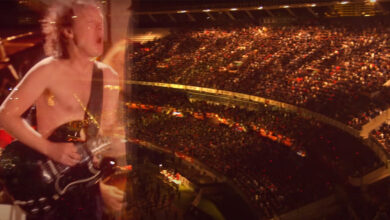Metallica’s “Monsters of Rock” performance in Moscow drew over 1.6 million people in 1991
In the waning days of the Soviet Union, an event occurred that would leave an indelible mark on the history of rock music and the cultural landscape of Eastern Europe. The year was 1991, and the “Monsters of Rock” festival was set to take place in Moscow. This festival was not just another concert; it was a symbol of the sweeping changes occurring across the region. On September 28, over 1.6 million people gathered at the Tushino Airfield in Moscow to witness an event that would forever alter their perception of the world and their place within it.
The backdrop to this event was a nation in transition. The Soviet Union was on the verge of dissolution, and the winds of change were sweeping across the country. Western music, which had long been suppressed, began to find its way into the hands of the youth, offering them a taste of the freedom and rebellion that was a hallmark of rock and roll. The “Monsters of Rock” festival, headlined by Metallica, represented a convergence of these forces, a loud and unmistakable declaration that the times were indeed changing.
Metallica was already a powerhouse in the world of rock music by 1991. Their albums had sold millions of copies worldwide, and they had a reputation for delivering powerful, high-energy performances. Sharing the stage with other rock giants such as AC/DC and Pantera, Metallica’s presence was a major draw for the festival. However, the enormity of the crowd that assembled to see them exceeded all expectations. Over 1.6 million people, making it one of the largest gatherings for a rock concert in history, flocked to the airfield, creating a sea of humanity that stretched as far as the eye could see.
As the festival kicked off, the atmosphere was charged with excitement and anticipation. For many in the crowd, this was their first opportunity to see their musical idols live, an experience that had seemed unattainable just a few years earlier. The significance of the event was not lost on the attendees; it was more than just a concert—it was a symbol of liberation and a celebration of newfound freedoms. The air was thick with the scent of change, and the sound of Western rock music blasting through the speakers only amplified this sense of transformation.
When Metallica took the stage, the crowd erupted. The opening notes of “Enter Sandman” sent a jolt of electricity through the masses, igniting a wave of energy that would carry through the entire performance. The band delivered a blistering set, featuring a mix of their biggest hits and fan favorites. Songs like “Creeping Death,” “Fade to Black,” and “Master of Puppets” resonated deeply with the audience, many of whom were experiencing live Western rock music for the first time. James Hetfield’s powerful vocals and Kirk Hammett’s searing guitar solos cut through the air, creating an unforgettable auditory experience.
The interaction between the band and the audience was a crucial aspect of the performance. James Hetfield, the band’s frontman, took moments between songs to engage with the crowd, breaking down the barriers that had long separated East from West. His efforts to communicate, even with the language barrier, were met with enthusiastic responses, as the audience felt a direct connection to the band and the music. This was more than just a concert; it was a cultural exchange, a moment of unity that transcended language and ideology.
The logistical challenges of organizing an event of this magnitude were immense. The sheer number of attendees required unprecedented levels of coordination and security. Soviet military personnel were stationed around the venue, tasked with maintaining order and ensuring the safety of the crowd. For many of these soldiers, this was their first exposure to Western rock music, adding another layer of complexity to the event. Despite the potential for chaos, the festival remained largely peaceful, a testament to the unifying power of music.
The impact of Metallica’s performance in Moscow was profound and far-reaching. For the attendees, it was a life-changing experience, a moment of liberation and a glimpse into a world of possibilities. The concert inspired a generation of Russian youth, sparking a burgeoning rock and metal scene in the country. Bands that had been operating underground now found a supportive audience, and new bands formed, driven by the energy and inspiration they had drawn from the festival. The ripple effects of this event were felt for years to come, as the music scene in Russia continued to grow and evolve.
In the broader context of Metallica’s career, the Moscow performance solidified their status as global rock icons. It demonstrated their ability to connect with audiences on a massive scale, regardless of cultural or political differences. The band’s willingness to play in such a significant and transformative setting spoke to their commitment to their music and their fans. This performance became a defining moment in their legacy, a testament to the universal appeal of their music and the enduring power of rock and roll.
The festival at Tushino Airfield also holds a special place in the history of live music events. It remains one of the largest concerts ever held, a feat that is unlikely to be matched in terms of sheer numbers and historical significance. The sight of over a million people gathered in one place, united by their love of music, is a powerful reminder of the impact that live performances can have. It was a moment when music transcended its role as entertainment and became a force for change, a symbol of hope and a beacon of freedom.
Reflecting on this event, it is clear that the “Monsters of Rock” festival in Moscow was more than just a concert. It was a cultural milestone, a turning point in the history of the Soviet Union, and a defining moment for Metallica. It showcased the power of music to bring people together, to inspire and to challenge the status quo. For those who were there, it was an experience that would stay with them for the rest of their lives, a testament to the transformative power of rock and roll.
The legacy of this performance continues to resonate today. It serves as a reminder of a time when the world was on the brink of monumental change and how music played a crucial role in shaping that change. For Metallica, it was a validation of their influence and reach, cementing their place in the pantheon of rock legends. For the attendees, it was a moment of personal and collective liberation, a celebration of newfound freedoms and the beginning of a new era.
In the end, Metallica’s performance at the “Monsters of Rock” festival in Moscow was a landmark event in every sense of the word. It captured the spirit of a generation, reflected the tumultuous changes of the time, and highlighted the unifying power of music. The sight of over 1.6 million people gathered to celebrate rock and roll stands as a powerful testament to the enduring appeal of live music and its ability to transcend boundaries, both physical and ideological. It was a moment when music truly made history, leaving an indelible mark on all who experienced it and continuing to inspire generations to come.



